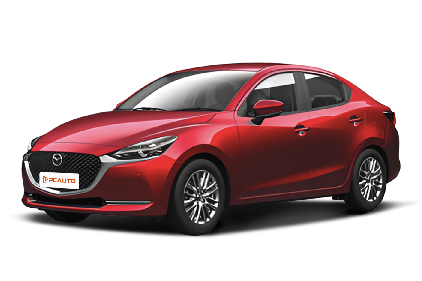Q
Is the Mazda 2 a good car?
The Mazda2 can be considered a commendable vehicle in many respects. Its sporty and stylish exterior design, with some models featuring the brand's signature "KODO" design, makes it quite eye-catching. In terms of performance, the 1.5-liter engine provides ample power for everyday driving, delivering a maximum output of 114 horsepower and a torque of 149 Nm. With front-wheel drive and an automatic transmission, the driving experience is smooth. It also comes with engine start-stop technology to enhance fuel efficiency, boasting an official fuel consumption rate of just 5.3 liters per 100 kilometers.
Safety features are standard, including Anti-lock Braking System (ABS), Electronic Stability Control (ESC), dual airbags, and ISOFIX child seat anchors. The interior features a 7-inch touchscreen, six speakers, as well as comfort amenities like keyless entry and single-zone automatic climate control.
However, like any vehicle, it has its limitations. Some may find the rear seat space a bit cramped for larger passengers. Overall, if you are in the market for a compact and efficient model suitable for daily commuting or city driving, the Mazda2 is a choice worth considering.
Special Disclaimer: This content is published by users and does not represent the views or position of PCauto.
Related Q&A
Q
Does Mazda 2 have folding mirrors?
Yes, the Mazda2 Comes Standard with Power Folding Side Mirrors. This convenient feature allows you to easily fold the mirrors inward, which is especially useful for parking in tight spaces or navigating narrow roads, helping to protect the mirrors from potential damage.
In addition, the Mazda2 offers other mirror-related functionalities. Its side mirrors provide excellent visibility with no blind spots, and they have a small frontal area that reduces wind resistance. Furthermore, it is equipped with a mirror heating function, controlled by a switch located near the climate control panel, shared with the rear defroster. When activated, both the rear windshield and the exterior side mirrors will be heated for 15 minutes to eliminate fogging in rainy or snowy weather.
Q
Is the Mazda 2 the same as the Toyota Yaris?
The Mazda 2 is different from the Toyota Yaris. In terms of body structure, the Mazda 2 offers 4-door 5-seat sedan models, while the Yaris is typically a 5-door 5-seat hatchback. Their dimensions also vary, which affects interior space. For example, different models have different lengths, widths, heights, and wheelbases.
In terms of performance, although both may be equipped with petrol engines, their power output, torque, and fuel consumption differ. The Mazda 2 has its own unique engine tuning and performance characteristics.
Regarding features, each vehicle comes with its own set of standard and optional equipment, including safety features, infotainment systems, and comfort amenities. For instance, the headlight types, seat adjustment methods, and air-conditioning zoning may vary between the two models. Therefore, the Mazda 2 and Toyota Yaris are distinct vehicles with their own characteristics.
Q
How often should the Mazda2 be serviced?
The maintenance frequency for the Mazda2 depends on various factors. Generally speaking, under normal driving conditions, it is recommended to follow these guidelines. The first service is typically advised at around 5,000 kilometers or about 6 months of use, which helps to inspect vehicle components during the initial break-in period. After the first service, subsequent general maintenance intervals are usually every 10,000 kilometers or 12 months.
However, if you drive under harsh conditions, such as in dusty environments, frequent stop-and-go traffic, or short trips, you may need to service your vehicle more frequently. In this case, changing the oil and oil filter every 5,000 kilometers or every 3-6 months is a good practice. In dusty areas, the air filter may need to be cleaned every 10,000 kilometers or 6 months, while it should be replaced every 20,000 kilometers or 24 months under normal conditions. Brake fluid should be regularly checked and replaced every 2-4 years, depending on usage.
Regular maintenance not only ensures that your Mazda2 runs smoothly but also extends its lifespan and enhances safety.
Q
Is Mazda 2 economical?
The Mazda2 is considered a relatively economical model. It is equipped with a 1.5L naturally aspirated engine, with an official combined fuel consumption of 5.3L/100km. This level of fuel efficiency is commendable among its peers, helping owners save on fuel costs. Additionally, the vehicle comes with a warranty of 5 years or 100,000 kilometers, providing a longer coverage period that can help mitigate potential high repair expenses in the future.
In terms of pricing, taking the 2023 Mazda 2 Sedan 1.5L as an example, it is priced between RM97,000 and RM107,000 (depending on the variant), making it competitively priced in its segment. The interior features are quite practical, with standard equipment such as automatic parking assist and engine start-stop technology, which not only facilitates driving but also aids in fuel saving. While it may not be the most powerful in terms of performance, considering fuel efficiency, warranty, price, and other factors, the Mazda2 demonstrates solid value in terms of economy, making it an ideal choice for consumers seeking a budget-friendly and practical vehicle.
Q
Is the Mazda 2 a family car?
The Mazda2 can be seen as a family vehicle. It features a 5-seat layout, making it suitable for the daily travel needs of small families. While the interior space isn't particularly large, it provides sufficient room for passengers, and the rear seats come with a 60:40 split-folding function, allowing for increased cargo space when needed for items like strollers or groceries.
In terms of safety, it comes standard with features such as ABS, electronic stability control, at least two airbags, and ISOFIX child seat anchors, which are all crucial for a family car. Fuel efficiency is also a significant highlight, with an official combined consumption of 5.3 liters per 100 kilometers, helping to lower everyday travel costs. Additionally, it boasts convenient features like keyless entry, automatic climate control, and a touchscreen infotainment system, enhancing overall comfort for family journeys.
Q
Does Mazda 2 have reversing camera?
Yes, the Mazda 2 is equipped with a reversing camera. All listed Mazda 2 models feature a "parking image system: front and rear cameras," indicating they come with both front and rear cameras, including a reversing camera. This feature is highly practical as it provides drivers with a clear view of the area behind the vehicle when reversing. It enhances safety by minimizing blind spots and making it easier to avoid collisions with obstacles, pedestrians, or other vehicles. Additionally, the inclusion of this feature increases parking convenience in various scenarios, whether in tight parking spaces or on busy streets.
Q
Is Mazda 2 a sport car?
The Mazda 2 is not a traditional sports car in the strict sense, but it does possess some sporty characteristics. Its engine delivers relatively smooth and linear power output. For instance, the equipped 1.5L naturally aspirated engine produces a maximum horsepower of 114PS and provides responsive power delivery as the revs climb. Regarding the suspension system, the tuning of the front MacPherson strut and rear torsion beam independent suspension ensures daily driving comfort while maintaining adequate cornering support to reduce body roll. Externally, it inherits the family's "Kodo" design style, featuring a shield-shaped front grille integrated with sleek headlights, flowing side profiles, and a compact yet refined rear end that conveys athleticism. However, sports cars typically prioritize high-performance engines, lightweight construction, and robust power output. The Mazda 2 primarily targets the mainstream consumer market, emphasizing overall practicality, fuel efficiency, and comfort rather than being designed as a dedicated sports car focused on extreme speed or track performance.
Q
Does the Mazda 2 have a touch screen?
The latest Malaysian version of the Mazda2 (2024) is not equipped with a traditional touchscreen. Instead, it features a 7-inch non-touch central display, which operates through the Mazda Connect infotainment system using a rotary knob and buttons on the center console. This design aims to reduce driver distraction and enhance safety.
Although it doesn't support touch input, the system is compatible with Apple CarPlay and Android Auto (via wired connection), allowing users to easily access navigation, music, and other smartphone features. Mazda adheres to a "driver-oriented" design philosophy, ensuring that even the entry-level Mazda2 does not compromise on the logic of operation. While users who heavily rely on touch controls may need a brief adjustment period, the precision and smoothness of the rotary control prove to be very practical in Malaysia's driving conditions.
Q
Does the Mazda2 perform well on the highway?
The Mazda 2 performs well on the highway. It is equipped with a 1.5L naturally aspirated engine, paired with a 6-speed automatic transmission, delivering 114 horsepower and 149 Nm of torque, which meets normal acceleration and overtaking demands on the highway. In terms of handling, Mazda's precise steering system stands out as a key advantage. At high speeds, drivers can accurately control the vehicle's direction. Its well-tuned suspension system effectively absorbs road imperfections and minimizes body roll, ensuring a stable driving experience. For safety, standard features include ABS anti-lock braking and vehicle stability control, providing added security during highway driving. The cabin also offers amenities like a HUD head-up display and a multifunction steering wheel, enhancing driving convenience. However, Mazda vehicles typically have room for improvement in noise insulation at high speeds since the Mazda 2's wind and road noise may be somewhat noticeable on the highway.
Q
What engine is a Mazda 2 equipped with ?
The Mazda 2 is equipped with a 1.5L naturally aspirated engine with an NA intake system, an inline (L) cylinder configuration, and four cylinders. This engine delivers a maximum horsepower of 114PS, with peak power output at 6000rpm and maximum torque of 149N·m at 4000rpm.
The engine provides stable power output to meet daily driving demands. It incorporates multiple advanced technologies, such as an automatic start-stop system that shuts off the engine during brief stops and restarts when moving off, helping to save fuel and reduce emissions. The hill-start assist function prevents rollback when starting on inclines, enhancing driving safety. Additionally, the engine is paired with an AT transmission for smooth gear shifts and improved driving comfort.
Latest Q&A
Q
Are 2020 Honda Accords good?
The 2020 Honda Accord has performed exceptionally well in the Malaysian market, making it a midsize sedan worth considering. Its 1.5-liter turbocharged engine delivers 193 horsepower, striking a good balance between fuel efficiency and driving enjoyment. The CVT transmission offers impressive smoothness, ideal for both city commuting and long-distance drives. The interior features soft-touch materials and a 7-inch infotainment system with Apple CarPlay and Android Auto support, catering well to local user needs. On the safety front, it comes standard with the Honda Sensing suite, including adaptive cruise control and lane-keeping assist, which is quite leading in its class. It also holds its value better than average in the used car market, suiting buyers who prioritize practicality and reliability. If budget allows, the hybrid version is a solid choice with even better fuel economy. Competitors in its class include the Toyota Camry and Mazda 6, but the Accord has the edge when it comes to space and tech features. It’s advisable to take a test drive and compare configurations across different model years before making a purchase.
Q
What kind of engine is in the Honda Accord 2020?
In the Malaysian market, the 2020 Honda Accord mainly offers two engine options: the 1.5-liter VTEC Turbo and the 2.0-liter hybrid. The 1.5T engine cranks out 194 horsepower and 260 Nm of torque, paired with a CVT gearbox that balances power and fuel efficiency, making it ideal for daily driving needs. On the other hand, the 2.0-liter hybrid variant combines a 2.0-liter Atkinson-cycle engine with a dual-motor system, delivering a combined 215 horsepower and using an E-CVT transmission for even better fuel economy—perfect for consumers who prioritize energy efficiency. Both engines showcase Honda's refined application of Earth Dreams Technology. The 1.5T engine uses direct fuel injection to boost combustion efficiency, while the hybrid system optimizes energy use by intelligently switching between pure electric, hybrid, and engine-driven modes. It's worth noting that Malaysia's hot climate demands good heat dissipation for turbocharged engines, but Honda's cooling system design has been optimized for tropical environments. The hybrid model's battery pack also comes with a temperature management system to ensure stability. Consumers can choose based on their budget and usage habits: the turbocharged version suits those who prefer a traditional driving feel, while the hybrid is better for frequent city commuting.
Q
Is the 2020 Accord a good first car?
The 2020 Honda Accord makes a solid pick for young Malaysians buying their first car. It’s known for being reliable, fuel-efficient, and having a roomy interior—perfect for daily commutes and family use. The 1.5T or 2.0T engine strikes a nice balance between power and fuel economy, and the smooth CVT transmission adds to the driving comfort. On the safety front, the Honda Sensing suite, which includes adaptive cruise control and lane-keeping assist, gives new drivers that extra peace of mind. The interior is clean and functional, with materials and build quality that are above average for its class. The trunk space is also big enough for most needs. In Malaysia, Honda has a pretty well-established after-sales network, so maintenance is relatively hassle-free and reasonably priced. As a midsize sedan, it holds its value well on the used market, making it economical in the long run. For first-time buyers, beyond the car itself, it’s important to factor in road tax and insurance costs in Malaysia—they do add to the overall ownership expenses. Also, new drivers should definitely test-drive it first to make sure it fits their driving style and body type. After all, a comfortable driving position matters a lot, especially on longer trips.
Q
How fast can a Honda Accord 2020 go?
The top speed of the 2020 Honda Accord varies by engine configuration. The 1.5-liter turbocharged version maxes out at around 190 km/h, while the 2.0-liter turbo model can hit approximately 210 km/h. Actual performance might be affected by road conditions, vehicle load, and local climate. In Malaysia, this kind of power is more than enough for daily driving and highway cruising. The Accord also stands out for its smooth CVT transmission and fuel efficiency. It's worth noting that Malaysia's legal highway speed limit is 110 km/h, so it's advisable to stick to traffic rules for safety. If you're craving more performance, you can use the Sport mode or paddle shifters to enhance the driving experience, but always remember that safe driving should be your top priority.
Q
What is the common problem of the Honda Accord?
Common issues with the Honda Accord in Malaysia mainly center around the transmission. Earlier model years, in particular, might experience rough shifting or delays, which is linked to transmission fluid degradation from prolonged use in the tropical climate. It’s advisable to regularly check or proactively replace the fluid with the OEM-specified type. Additionally, some owners have reported occasional lag with electronic systems like the infotainment screen – this can usually be fixed with a software update at the dealership. Notably, while the Accord’s Earth Dreams engine technology is efficient, it may develop slight oil consumption after long-term high-load driving; regular oil level checks will prevent any impact on engine performance. Given Malaysia’s rainy climate, it’s recommended to pay special attention to regularly cleaning the sunroof drain tubes to prevent blockages that could lead to interior water leakage. The suspension tuning of this model leans towards comfort, but bushing wear may occur after several years of use, manifesting as rattling noises when going over speed bumps – replacing the bushings will restore quietness. As a model that has long ranked among the top-selling D-segment sedans in Malaysia, the Accord still maintains excellent overall reliability; proper maintenance can significantly extend its service life, and its strong resale value in the used car market is a testament to local consumers’ trust in its quality.
View MoreRelated News

Rumor: Toyota and Mazda collaborate to develop the next-generation MX-5 and GR86
AshleySep 30, 2025

MAZDA EZ-60 will be launched in China, and will be available in other global markets in 2026
RobertSep 30, 2025

CX-80 too large? Too expensive? Mazda also offers you the CX-60
WilliamSep 4, 2025

Mazda Malaysia Launches its Largest SUV, the CX-80, with a Price of RM331,610
Kevin WongSep 4, 2025

Mazda Australia stated that there are currently no plans to launch an electric version of the BT-50.
LienAug 28, 2025
View More

















Pros
Cons